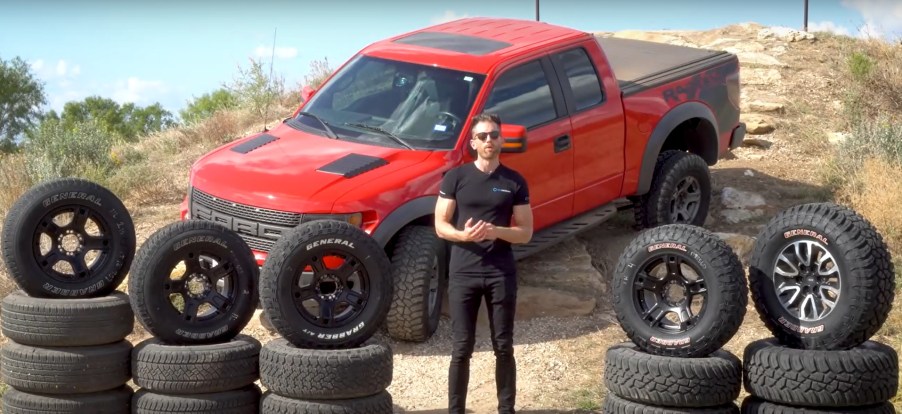
Which Truck Tires Do You Actually Need?
Tires are your truck’s shoes. You wouldn’t wear a dress shoe to go hiking, and you wouldn’t put a street tire to go off-roading. But between the truck tire extremes is a gray area. Can, or should, you put an off-road tire on a mostly urban-riding pickup? Do big tires actually do anything useful?
YouTube channel Tyre Reviews teamed up with General Tire at their Texas tire-testing facility to find out. Host Jonathan Benson, using a Ford SVT Raptor, tested four different tires: street, mild off-road, aggressive off-road, and mud. He also tested the mud tire in two different diameters, to compare what an over-size tire brings to the table.
Truck Tire Background

In the video, the terms ‘H/T’, ‘A/T’, and ‘M/T’ are thrown around. If you own an SUV or truck, you may have seen these symbols on your vehicle’s tires already. They refer to what kind of surface the tire is rated for.
‘H/T’, or ‘Highway Terrain’, is meant primarily for paved roads. ‘A/T’, or ‘All Terrain’, is what you turn to when the pavement stops and dirt begins. A/T tires can freely transition between on- and off-road driving. ‘M/T’, or ‘Mud Terrain’, on the other hand, is intended for hard-core off-roading.
The more off-road rated a tire is, the more rugged the tread design. The chunky tread helps fling road hazards like water, gravel, sand, and mud away to improve grip and handling. However, this also impacts on-road behavior: braking is worse, as is steering, and the tires get noisier.
Tire Testing Layout
All four tires tested came from General Tire’s Grabber line. The H/T tire was the HTS60, the A/T tires were the APT and the more aggressive ATx, and the M/T tire was the X3. All four tires came in 265/70 R17 size, with an additional Grabber X3 oversize choice coming in LT315/70 R17 size. Ford originally equipped the first-gen SVT Raptor with BFGoodrich A/T tires, which makes sense considering the truck’s intended purpose.

Testing was performed in a variety of conditions. First came dirt and gravel handling, on specially prepared courses. Next came wet handling and braking, performed on General Tire’s paved wet skidpad. Dry handling, noise-vibration-harshness, as well as rolling resistance and comfort were then measured on a different paved track. Finally, due to the risk of possible truck damage (which was validated), came mud performance.

For all the tests, Tyre Reviews gathered both objective data—lap times, braking distances, noise levels—as well as subjective observations. After all, it doesn’t matter how good the numbers are if the driver doesn’t feel safe or confident in the tire.
Results

Unsurprisingly, the tires generally performed best in the road environments they were designed for. On pavement, the street HTS60 dominated braking and handling, both objectively and subjectively. It was also the most comfortable on-road.

As the testing moved off-road, the A/T and M/T tires showed their merits. On the hard-packed Texas dirt, the ATx was best, while on the slipperier gravel the X3 proved superior. However, although the APT edged it out off-road, the HTS60 was surprisingly not terrible when the pavement ended.
Naturally, when the dirt turned to mud, the X3 was the best. Unfortunately, the 315 X3 couldn’t be tested in the mud. The Raptor broke during testing, and the tires wouldn’t fit on the replacement Nissan pickup.

Speaking of large tires, as it turns out, there is some benefit to them. With more rubber brought to bear, the 315 X3 outperformed its smaller version in dirt and gravel handling, both objectively and subjectively. On pavement, while the extra rubber did improve braking distance and course time, both M/T tires were ranked equally last in subjective wet handling, with the 315 X3 just edging out in subjective dry handling. Unfortunately, fitting bigger tires means comfort gets worse.
So Which Truck Tires Do You Need?
Jonathan lays it out very well in his video. If you’re spending more than 70% of your time on paved roads, there’s little reason to fit A/T or M/T tires beyond visual appeal. But both objectively and subjectively, an H/T tire like the Grabber HTS60 is the better choice.

If you spend more time off-roading, a mild A/T tire like the Grabber APT is a great choice, as it performs better off-road than the HTS60 while being better on-road than the more aggressive ATx. However, when on-road/off-road time starts skewing more towards off-road, the ATx is the way to go.
The Grabber X3, while it does make your truck look tough, is really best kept out of the city. But at least you can fit the big tires without looking like a poser.


